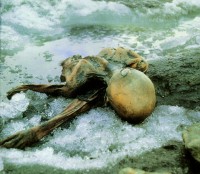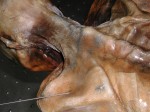 Oetzi the Iceman was discovered protruding from the ice of a glacier in the Oetzal Alps of the South Tyrol by hikers on September 19th, 1991, and in the years since has become the most studied mummy in the world. Kept in a climate controlled chamber with a viewing window for visitors at the South Tyrol Museum of Archaeology in Bolzano, Italy, Oetzi is under constant monitoring by researchers who use the latest and greatest technology to discover new information about his life and death with as little interference with the remains and artifacts as possible.
Oetzi the Iceman was discovered protruding from the ice of a glacier in the Oetzal Alps of the South Tyrol by hikers on September 19th, 1991, and in the years since has become the most studied mummy in the world. Kept in a climate controlled chamber with a viewing window for visitors at the South Tyrol Museum of Archaeology in Bolzano, Italy, Oetzi is under constant monitoring by researchers who use the latest and greatest technology to discover new information about his life and death with as little interference with the remains and artifacts as possible.
The question of what he ate in the day or days before someone shot an arrow in his back severing his subclavian artery — he bled to death within minutes — was previously addressed by analysis of the fecal material found in his bowels. They contained the remains of red deer meat and some kind of cereal eaten at least four hours before his murder. In 2011, microbiologists at the Institute for Mummies and the Iceman in Bolzano reexamined CT scans from 2005 and discovered something previous researchers had missed: Oetzi’s stomach. It had shifted north, which is why it was missed the first time, and it appeared to be full.
 A sample of the stomach contents contained animal fibers which DNA analysis identified as Alpine ibex meat. This was his last meal, ingested 30 to 120 minutes before he died. The meat of the Alpine ibex was traditionally believed to have medicinal properties, and since Oetzi suffered from chronic joint pain, Lyme disease, periodontal disease, ulcers and a panoply of non-fatal wounds including knife cuts and blunt force trauma to his teeth received in the days and hours before his death, he had more than enough reasons to seek out healing foods.
A sample of the stomach contents contained animal fibers which DNA analysis identified as Alpine ibex meat. This was his last meal, ingested 30 to 120 minutes before he died. The meat of the Alpine ibex was traditionally believed to have medicinal properties, and since Oetzi suffered from chronic joint pain, Lyme disease, periodontal disease, ulcers and a panoply of non-fatal wounds including knife cuts and blunt force trauma to his teeth received in the days and hours before his death, he had more than enough reasons to seek out healing foods.
New research has been able to narrow down how the Ibex meat was prepared.
Mummy specialist Albert Zink from the European Academy of Bolzano said he was able to analyse the nanostructure of meat fibres from a mountain goat found in Ötzi’s stomach – indicating that the meat was raw and had been dry-cured, and not cooked or grilled, which would have weakened the fibres.
He added that Ötzi did not have a proper hunting bow with him, and probably carried the dried meat with him from his home, as raw meat would have quickly gone bad.
Further analysis of his stomach contents showed that he had not eaten cheese or dairy products, just meat. “It seems probable that his last meal was very fatty, dried meat – perhaps a type of Stone Age Speck or bacon,” Zink said. As Ötzi had hiked down from the South Tyrolean side of the Alps, it’s likely his provisions came from there.
Speck is a famous local delicacy in the Tyrol. Cured with salt and spices and cold-smoked, Tyrolean Speck goes back to the 13th century. Little did we know that it was being made from wild mountain goats in the area 4,000 years before it was made from the hind legs of pigs. I’m not sure how fatty ibex meat can possibly be, though. These animals are accustomed to scrambling up and down the Alps, after all, not chilling in a wallow.